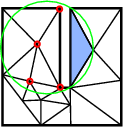Next: 2.4 Data Structure for Meshes Up: 2 Geometries and Meshes Previous: 2.2.2 Mesh Element Quality and Mesh Quality Contents

![\begin{subfigure}
% latex2html id marker 2604
[b]{0.45\textwidth}
\centering
\...
...3.71cm]{figures/delaunay}
\caption{Triangle which is Delaunay}
\end{subfigure}](img436.gif)
![\begin{subfigure}
% latex2html id marker 2611
[b]{0.45\textwidth}
\centering
\...
...figures/not_delaunay}
\caption{Triangle which is not Delaunay}
\end{subfigure}](img437.gif)
In the upper picture, a triangle (colored in blue) which is Delaunay in the mesh is shown. The lower picture visualizes a triangle (colored in blue) which is not Delaunay due to the red vertex which is inside the triangle's circumball and therefore breaks the Delaunay property of the triangle. |
![\begin{defn}
% latex2html id marker 2636
[Visibility]
Two points $\bm{x},\bm{y} ...
...cf.~Definition~\ref{def:simplex}) respects the PLC ${{\mathcal{P}}}$.
\end{defn}](img457.gif)
![\begin{defn}[Constrained Delaunay]
Let ${{\mathcal{P}}}$\ be a PLC and ${({\math...
...})}$\ is constrained Delaunay, if every cell is constrained Delaunay.
\end{defn}](img458.gif)

The blue triangle certainly is not Delaunay, because there are four vertices (indicated by red circles) which lie within the triangle's circumball. However, the triangle is constrained Delaunay, because the PLC boundary blocks the visibility of these vertices to the triangle. |
![\begin{defn}
% latex2html id marker 2658
[Edge-protected]
An element space ${\ma...
...{E}})$\ (cf.~Definition~\ref{def:cells_facets}) is strongly Delaunay.
\end{defn}](img470.gif)
florian 2016-11-21